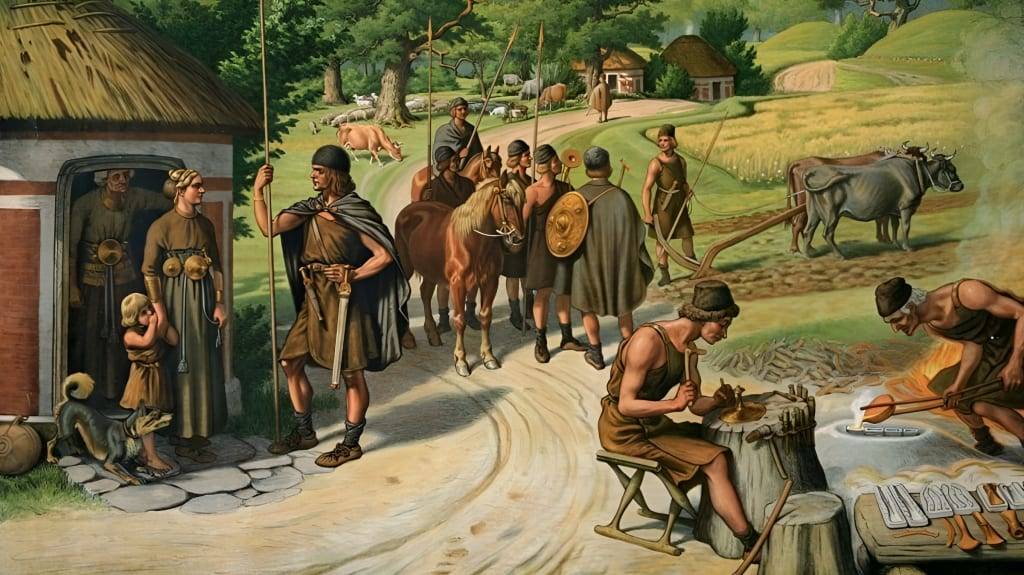Since the dawn of humanity, civilizations have risen and left their marks on history. We are well acquainted with the grandeur of ancient Egypt, the ingenuity of the Sumerians, the wisdom of Chinese dynasties, and the mystery of the Indus Valley civilization. In Europe, we have explored the legacies of the Minoans and the Etruscans. But this time, we venture further back in time to uncover one of the most ancient and enigmatic civilizations of Europe—the Cucuteni-Trypillia culture.
In 1885, Romanian ethnographer Teodor Burada was walking along a gravel road in the small village of Cucuteni, Romania, when something unusual caught his eye—fragments of ceramic pottery scattered among the stones. His curiosity led him to a nearby quarry, where he found even more artifacts, including terracotta figurines. Burada, along with fellow scholars Nicolai Bicen and George Diamandi, began the first official excavations of Cucuteni that same spring. Little did they know, they had stumbled upon one of Europe’s earliest civilizations.
Around the same time, in present-day Ukraine, archaeologist Vikentiy Khvoyka uncovered similar findings near a village called Trypillia, approximately 50 kilometers south of Kyiv. These discoveries, spanning Romania, Ukraine, and Moldova, revealed a previously unknown cultural complex. Over time, this civilization became known as the Cucuteni-Trypillia culture, an ancient society that predates many of the well-known European civilizations and rivals the antiquity of Mesopotamia and Egypt.
The Cucuteni-Trypillia culture flourished between approximately 5500 BCE and 2750 BCE, covering an extensive area from the Carpathian Mountains to the Dniester and Dnieper rivers. At its peak, it spanned nearly 350,000 square kilometers across present-day Romania, Moldova, and Ukraine. Despite their early origins, these people developed a remarkably advanced society, constructing some of the largest settlements of Neolithic Europe, with populations reaching up to 46,000 inhabitants.
One of the most fascinating aspects of their culture was their peculiar practice of periodically burning down their own settlements. Archaeological evidence suggests that Cucuteni-Trypillia houses had a lifespan of 60 to 80 years before being deliberately set ablaze. The reasons for this practice remain a subject of debate among historians. Some believe it was a form of ritual purification, while others suggest it was a method of renewal and reconstruction.
The Cucuteni-Trypillia people were skilled artisans, farmers, and traders. They lived in small, self-sufficient communities spread out by 3-4 kilometers, emphasizing local autonomy. Their society showed little evidence of hierarchical structures, suggesting a relatively egalitarian way of life without kings or ruling elites.
Agriculture and animal husbandry were central to their economy. They cultivated wheat, barley, and legumes while domesticating cattle, sheep, and pigs. Unlike many contemporary cultures, they exhibited a communal lifestyle, with no apparent social stratification.
One of their most notable artistic achievements was their sophisticated ceramic craftsmanship. Cucuteni-Trypillia pottery was handcrafted using a coiling technique and often decorated with intricate swirling patterns. These designs, featuring geometric motifs, may have held symbolic meanings related to their beliefs and cosmology. Some evidence suggests they developed an early form of a slow-turning potter’s wheel, a technique that would not become widespread in Europe until the Iron Age.
Numerous clay figurines found in archaeological sites suggest that spirituality played a significant role in Cucuteni-Trypillia society. Many of these figures depict women, leading some scholars to speculate that the culture had a strong matriarchal or fertility-centered belief system. These figurines, often referred to as "goddesses," might have been used in religious rituals, serving as protective amulets or symbols of prosperity.
Although burial sites from this culture are rare, a significant discovery was made in the Verteba Cave in western Ukraine. This site contained human remains spanning over a thousand years, providing valuable insights into their genetic origins. DNA analysis revealed connections between the Cucuteni-Trypillia people and early European Neolithic farmers, as well as steppe populations from the east, highlighting a blend of genetic and cultural influences.
Like many ancient civilizations, the fate of the Cucuteni-Trypillia people remains a mystery. Scholars propose several theories regarding their disappearance. Some suggest that they gradually assimilated into emerging Bronze Age societies, while others argue that environmental changes or resource depletion forced their decline.
One of the most debated theories is the Kurgan Hypothesis, proposed by archaeologist Marija Gimbutas. This theory suggests that waves of Indo-European steppe nomads, known as the Kurgans, invaded the Cucuteni-Trypillia territories around 3000 BCE. These nomads, who were skilled horse riders and warriors, might have either displaced or assimilated the Cucuteni-Trypillia people, marking the transition from the Neolithic to the Bronze Age.
Despite their eventual disappearance, the Cucuteni-Trypillia culture left an indelible mark on history. Their innovations in ceramics, settlement planning, and communal living set the foundation for future European societies. Long before the pyramids of Egypt were built or the first written records emerged, these ancient Europeans thrived, creating a unique and complex society.
The story of the Cucuteni-Trypillia culture is a reminder of how much remains hidden in the depths of history, waiting to be uncovered. As archaeology continues to advance, we may one day unravel the full story of this forgotten civilization, bridging the gap between the past and the present.


